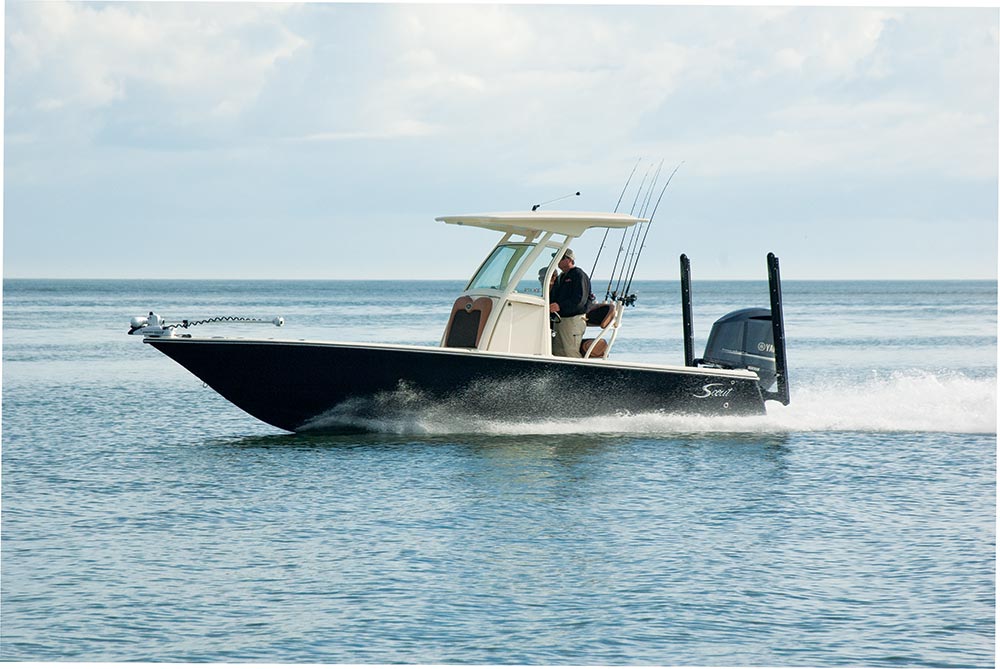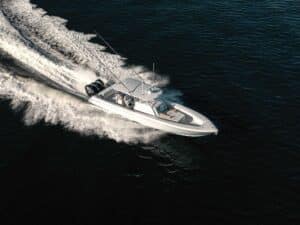
Scout 251 XS Running Shot
Mention “bay boat,” and most anglers think small center-console. But there’s nothing miniscule about the Scout 251 XS. A proud bow and expansive fore and aft decks make a striking first impression. With a Yamaha F350 on the transom, the 251’s stylish lines are punctuated with sheer power.
I boarded my test boat in Mount Pleasant, South Carolina’s famed Shem Creek, a working waterway since the 1700s. The creek quickly empties into Charleston Harbor, where my captain for the day, James LaVanway (Reel Fish Finder Charters), turned the 251 east.
A serene sunrise promised to make this early-December day pleasant. Soon we were snaking through fast-moving tidal creeks, banking easily in tight turns before slowing near a set of wooden docks opposite a sprawling salt marsh.
Angler Ready
LaVanway uses a 251 XS in his charter business, but he runs a Yamaha F300, which has become the most popular power option for this model, according to Scout. My test boat also showcased Scout’s redesigned casting platforms, which spurred the reintroduction last year of this 2012 model.
LaVanway had already filled the 28-gallon aft recirculating release well with a few dozen shrimp and mud minnows to tempt some low-country redfish and trout. A second 15-gallon livewell under the starboard transom seat could easily have accommodated the small baits as well.
Scout usually includes a third 40-gallon livewell — in the leaning post — as a standard feature, but my test boat came with only the cushioned, powder-coated frame as helm seating.
LaVanway first staked out the boat next to the marsh edge, using the twin optional Power-Poles. He handed out spinning rods and reels spooled with 10-pound-test to me and to Scout customer-service rep George Douglas, who had joined us for this Fish Trial. The rods had been nested in vertical holders beside the console; Scout padded the deck beneath the rods to prevent marking — a nice touch.
We tried casting jig heads tipped with artificials, working them down the creek as slowly as the rushing current would allow. I hopped up to the foredeck: a broad fiberglass platform created with the optional extension piece, which converts to a table.
Even though it’s a bit of a step from sole to deck, I felt very secure because of the platform’s sheer size. Six optional rod holders rimming the bow gave me a place to rest the rod while I took photos.
Redfish Frenzy
The creek grew a little crowded with boats, and we picked up only an occasional trout, so LaVanway moved to an area between docks and staked out again. We switched to pinning live bait onto the jig heads, and LaVanway showed us how to pitch the bait up-current and let it bounce back naturally. “Let it fall off that oyster-reef ledge, and they’ll hammer it,” he said.
The redfish could not resist. We hooked up on every cast. I tried fishing amidships, next to the console, and found it easy to side-arm the jig around the dock and up into the flowing, sandy-green creek. The three of us had plenty of room in all locations to cast and stay away from each other, despite the 251’s optional hardtop.
Whenever I released a fish, it was a very easy reach to the water’s surface. Where I stood, the gunwale hit my midthigh (though I’m admittedly smaller than most anglers). I did appreciate feeling a modicum of safety from that freeboard, particularly since the water temperature in December would be considered chilly.
From the aft deck, LaVanway culled our catch, placing a few legal-size reds into the release well. At one point, he stepped to the port side of the aft deck and cast into the creek. I noticed very little discernible weight shift. With the liveys, he picked up several fat seatrout, which joined the reds in the well.
The ferocious bite lasted for about an hour. As the tide ebbed off, the hookups slowed.
Inshore and Offshore
LaVanway ran the 251 to a broader creek, which bordered an open sound. I took the helm and began checking the bay boat’s performance. The F350 comes standard with power-assist steering, so basic maneuvers proved silky smooth. Tight turns bled off a little speed, but the 251 powered out of them strongly.
The hole shot felt crisp; the 251 hit the 30 mph mark in 10 seconds. LaVanway pushed the throttles while I monitored my hand-held GPS. We reached a top speed of 58.1 mph at 5,800 rpm both with and against the diminished tidal current. At the top end, we achieved 1.7 mpg. With a lighter load, this boat should make 60 mph. (In fact, Scout’s own testing with a smaller, V-6 F300 on another hull carved out 60.1 mph and 2.31 mpg.)
We slowed to cruise, and LaVanway walked the vessel up and down through the rpm range, finally settling at an optimal speed of 36 mph at 3,700 rpm, and 2.9 mpg. That means that with the standard 80-gallon fuel tank, the 251 with an F350 offers a 232-mile range. (Again, Scout’s testing with an F300 found a 24.7 mph cruise, where that boat attained 3.98 mpg.)
The glassy inshore waters kept me from assessing this hybrid boat’s performance in any kind of chop. But where there are no waves, I can make wakes. Numerous circles and turns slopped up the creek. As I charged back through the 2-footers, the vessel met them solidly.
Of course, that’s no indication of how the 251 would handle actual seas. But with a slightly more aggressive transom deadrise angle (18 degrees) than most bay boats and Scout’s NuV3 variable-degree deadrise hull, the 251 should be a gracious host with a soft ride.
Classy Package
I asked our captain to drop me off on the nearby sand to shoot some photos, and he easily obliged. With the boat’s standard 10-inch jackplate, he could hoist the outboard high enough to float to the beach — my feet didn’t even get wet as I stepped off the bow. The dry hull weighs just 2,300 pounds, and with the lower unit tilted up, it can float in 13 inches of water.
Once back aboard, I wandered from stem to stern, checking out details. At the bow, my test boat came with a Minn Kota Riptide trolling motor wired to a plug inside the anchor locker. The foredeck featured deep port and starboard lockable storage fitted with horizontal rod holders; hatches all came gasketed and with gas-assist shocks.
Beneath the fiberglass insert that forms the full foredeck lies a huge, 45-gallon in-sole insulated fish box. Aft of that, the richly upholstered forward seat lifts easily for access to the console interior. The standard Fusion stereo and an optional battery charger easily tuck into this space, along with safety gear, tackle, lines, and spare clothing. A portable marine head can be added.
Often a front-runner in hull and structural design, Scout had added to my test boat its patented hardtop and tempered-glass enclosure, which is mighty welcome on cold days when the wind from a 40 mph run can freeze your face. This boat also featured a two-tone, beige-over-black helm station, a 12-inch Garmin GPSMAP 7212 multifunction display and the vessel’s standard trim tabs.
The richly colored, high–performance leaning post featured flip-up bolsters and ergonomically carved seatbacks for cradling the body at high speeds. Six rod holders lined the leaning-post frame. A slender walk-through transitioned to the back deck. Its three separate sections flip up to offer cushioned transom seating for four.
Every Extra
The elliptical release well beneath our middle transom seat held the remaining bait, five redfish and three trout. After a few photos, LaVanway released the reds, choosing to keep the trout for a lunch treat back at Shem Creek.
While I looked forward to a meal of freshly caught fish, I wished we had the time for a little offshore or nearshore fishing. I knew that the slightly higher freeboard of this bay boat, its well-thought-out fishable space, and its added comforts and amenities would be a worthy platform for an all-day adventure.
Yet when the folks from Water’s Edge restaurant laid that platter of fried trout fillets, collard greens and slaw in front of us at the bar, my morning ended just fine.
Performance
Power……….. Yamaha F350
Load….. Three adults, fishing gear,
full livewell, 60 gal. fuel
Top Speed….. 58.1 mph @ 5,800 rpm
Time to 30 mph….. 10 sec.
Best mpg 2.9 @ 36 mph (3,700 rpm)
Hull
LOA………………… 24 ft. 10 in.
Beam…………………. 8 ft. 6 in.
Deadrise……………. 18 deg.
Weight…….. 2,300 lb. (dry)
Draft……………………. 13 in.
Fuel………………………. 80 gal.
Max Power………… 350 hp
MSRP as tested….. $112,500
Scout Boats
Summerville, South Carolina
843-821-0068
scoutboats.com








